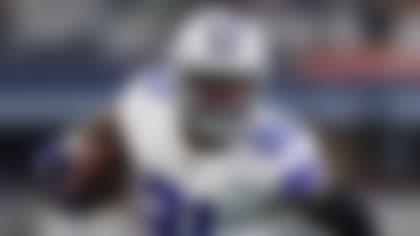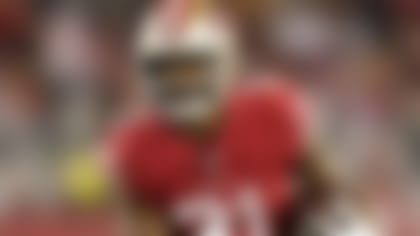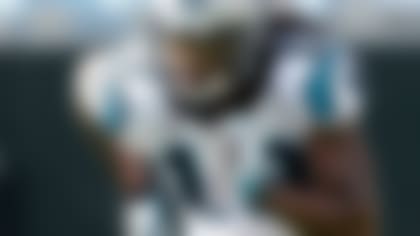Being negative isn't really my thing. In life I certainly prefer to reiterate and focus on the positive aspects. In player analysis, I think it's better to focus on what a wide receiver can do, rather than hammering him for what he can't do.
However, everything in fantasy football comes down to a value proposition and every year we see a handful of players who the community values improperly. Several of these receivers are excellent players who will help their NFL teams win and only one do I have questions about his on-field play. This is simply a cry to level out where they currently go in fantasy drafts.
To gauge the value of these players, I'll use the 12-team ADP from Fantasy Football Calculator early-down ability as I believe they provide the best glimpses of early drafts across fantasy players' skill-level. I'll compare those back to my tiered rankings to see who is going just a bit too early right now.
DeAndre Hopkins, Texans
I published this piece before J.J. Watt's reported back injury and potential lack of availability early in the season. The defensive splits from last season suggest that any hindrance to the Texans' stop-unit, which Watt's absence would certainly cause, is good news for Hopkins. I still think we should approach his redraft value with more caution than we currently are, but that new information is worth noting.
There's no denying DeAndre Hopkins is one of the best wide receivers in the NFL. A supreme talent whose technical mastery allows him to get every ounce out of his physical ability, Hopkins dominated last season. In just his third NFL season, Hopkins amassed 111 receptions and 1,521 yards to finish as the WR4 overall in PPR leagues.
There's no logical argument that paints Hopkins as anything but a superstar-level player. However, he is overvalued as a fantasy commodity this year should his consensus first-round ADP hold up.
Fantasy owners have a tendency to only remember either the beginning or end of the season when perusing end of season rankings. Yet, the NFL season is often multiple stories woven together into the quilt that forms a player's final fantasy numbers. It's important to contextualize each layer of Hopkins' 2015 story when projecting him for 2016.
During the first eight weeks of the regular season, Hopkins was a target monster. He averaged 14 targets per game and never received less than 11 in any contest. That volume helped him overcome a rotating quarterback carousel to average 8.25 catches, 108 yards and .75 touchdowns per game. Hopkins was the WR2 overall in standard fantasy leagues during that stretch.
However, after the Texans Week 9 bye, Hopkins' torrid pace naturally slowed down. He never saw more than 12 targets in any of his final eight games and averaged a more typical 10 per contest. His per game averages slipped to 5.6 catches, 81 yards and .63 touchdowns.
Normally there's a ton of noise in the data when breaking a season into two halves, due to the small sample size provided by the NFL season. In this case though, there may be a bit more benefit to the exercise than normal because we have a clear cause to the effect.
The Texans found a winning formula down the stretch with a strong 6-2 finish to their 2015 season after starting 3-5. Bill O'Brien's offenses have always favored a run-heavy approach since he entered the NFL. His units finished first and fifth in terms of run attempts in his first two seasons. They were forced to veer off their preferred approach in the first half of the season when their underperforming defense and dysfunctional offense put them in trailing positions all too often.
O'Brien's offenses always like to play with tempo, they've ranked eighth and first in plays run over his two seasons. But that was drastically inflated during their first eight games in 2015. The Texans ran 74 plays-per-game during that stretch, which was 10 more than the league average of 64 for the season. O'Brien also had to skew more pass-heavy than he prefers while the team played in so many negative game scripts averaging 5.6 passing plays per drive to just 2.6 rushing.
As mentioned, the winds in Houston changed after the bye week. The defense improved and the team started winning games. Consequently that returned the balance that O'Brien prefers to the play calling. In the final eight games of the season the Texans ran 3.59 rush plays per drive to 4.14 pass plays per drive. Their pace also slowed down to something closer to the league average running 66 plays per game.
As fantasy drafters, it should bring some concern that his numbers took a direct hit when the Texans started winning games. The Texans' offseason moves--taking two wide receivers on the first two days of the draft, paying a running back in free agency and talking up Jaelen Strong--are further proof they don't want Hopkins seeing the volume he did in 2015. He'll be hard pressed to crack 190 targets again even if he does maintain his elite-level 31 percent market share.
Unlike other regression candidates the community seems to insist we focus on, like Allen Robinson or Brandon Marshall, we already have on-field evidence of the conditions for a Hopkins slowdown. Yet, that already witnessed reality is not priced into his current ADP in the slightest. Some will argue that the new face at quarterback will elevate Hopkins, but Brock Osweiler is a conservative passer who performed worse than Brian Hoyer in predictive statistical categories like touchdown rate, interception rate and air yards per pass attempt. At best, it's a lateral move from the behind center play Hopkins got late in the season.
DeAndre Hopkins is a tremendous NFL player and the pinnacle of greatness among the crowded crop of young wide receivers in the league right now. However, he should not be the consensus fourth wide receiver off the board, as he is on ADP data across the industry. When you take into account talent and project volume, A.J. Green makes a far more convincing case to be that player.
There's little doubt that Hopkins finishes as a WR1 in fantasy firmly within the top-10. However, I have him in my second tier among receivers at WR9 overall in my latest rankings. That tier spans from WR5 to WR11 and Hopkins could certainly land anywhere in that group. He won't be a bust in fantasy this season, not even close, but the community ought to approach Hopkins' redraft stock with more caution than they are at this point.
Allen Hurns, Jaguars
The community is all abuzz about the Jaguars passing offense regressing with a projected improved defense and more emphasis on the ground game. Either way, repeating 35 touchdowns will be tough for Blake Bortles, so there's good reason for the thought.
Several analysts took aim at Allen Robinson all spring as premier regression candidate. Now, I might not be the picture of objectivity with Robinson, but he's the type of star-level player we should be betting on. While his rookie year Reception Perception was fantastic and foretold the massive season he would have in 2015, he got even better in his second season. He improved his success rate vs. man coverage from 71.7 to 73.6, his nine route success rate from 45.3 to 59.2 and his contested catch conversion rate from 64.3 to 75 percent.
He might not catch 14 touchdowns again this season, but Allen Robinson is without a doubt the type of player who could threaten for 90 to 100 catches at any point in his career. Robinson himself even mentioned to me that he will need to be even more efficient this year if the passing volume decreases this year. He's right up there with the best talents at the position and is well worth his current second-round ADP.
While still a solid player and a strong No. 2 option, Allen Hurns might not be able to withstand the decrease in passing volume. Hurns owned just a 17 percent share of the team's targets in 2015. If the run game becomes more of a focus and his market share remains the same, his targets could dip down into the low 90 to high 80 range from the 105 he saw last season.
There's also the matter of him sustaining his wildly high touchdown per target rate of 9.5. Hurns will have a tough time repeating his 10 touchdowns if Bortles truly does throw less inside the 20-yard line this season. Hurns had 15 percent (13) of the team's red zone targets last year and snared five touchdowns. However, that came with Julius Thomas hobbled and less involved than projected. Thomas was the player named by Robinson when I asked him to name someone who will take a step forward this year that we're overlooking in the media.
Right now there is no discount for any potential regression baked into Hurns' ADP. He goes off the board in the mid-fifth round as the WR26. That's a steep price to pay for a player who has several negative statistical red lights flashing around his projections. Paying a seventh or eighth round price for the talented Hurns makes complete sense, but he rarely falls to that range. Stick it out until that range of your draft and you'll find players with more intrigue and upside than paying the current sticker price for Hurns.
Larry Fitzgerald, Cardinals
The fantasy community spends much discussion on which Arizona Cardinals wide receiver we should target. John Brown and Larry Fitzgerald both finished inside the top-24 in fantasy points per game and Michael Floyd went over 100 yards receiving in five of his last eight games in 2015. Carson Palmer was the NFL's most efficient deep passer last year and Bruce Arians' offense makes all tides rise for the skill position players.
John Brown is one of my favorite receivers in the league and an elite downfield threat who can get open at all levels of the field. Michael Floyd might just be cracking his ceiling as he enters a contract year. Both of these ascending young wideouts are on upward trajectories heading into 2016. Their veteran teammate, however, is the only overvalued one of the trio based on his production when the offense was at full capacity down the stretch last season.
Larry Fitzgerald was the only stalwart last season among the Cardinals pass catchers when it came to health. Floyd struggled coming back from a hand injury early in the season, and Brown had several hamstring flare-ups in the midway point. Consequently, Fitzgerald accumulated the bulk of his fantasy scoring (70.9 percent) in his first nine games of the season. The receiving corps wasn't truly at full-force until the final third portion of the season. That time period also brought in another variable that hurt Fitzgerald's statistical output, the introduction of David Johnson into the offense.
The inclusion of Brown, Floyd and especially Johnson slashed a deep cut into Fitzgerald's productivity. His fellow wide receivers are the downfield threats in Arians' aggressive deep shot offense. When the long-time offensive coach arrived as the headman in Arizona, he asked Fitzgerald to move into a specialized slot receiver role. It's a short-area, chain-moving position that Arians had Hines Ward and Reggie Wayne play in years past and helps complement all the deep passing. It's an important spot for their offense, but it craters his fantasy scoring, especially in standard leagues.
In this position, Fitzgerald's aDOT (average depth of target) fell to 5.8. The only wide receiver to hold an aDOT that low over the course of the season was Golden Tate, who finished as the WR34 in standard leagues.
Across fantasy formats, but especially in PPR, we typically shouldn't turn our nose up at slot receivers in high-powered offenses even if their targets come in such short areas. However, the presence of David Johnson is a massive course-altering variable in the equation for Fitzgerald.
Because Johnson is such a unique receiving entity at the running back position, his role tends to intersect with Larry Fitzgerald's. Johnson doesn't just get dump-offs out of the backfield or run screens like most pass-catching backs do. He runs traditional routes further down the field like the slant and drag. His aDOT of 3.1 is abnormally high for a running back. Only two full-time backs (Devonta Freeman and Doug Martin) cracked two yards, while typical receiving backs like Theo Riddick and Danny Woodhead finished with aDOTs under one yard.
Johnson's demand of targets in the short game directly crosses into Fitzgerald's workload and caused his target share to dip below 20 percent from Weeks 13 to 17. Additionally, it sapped his red zone opportunities. The veteran receiver was one of the best players inside the 20-yard line in the early portions of the season, but finished behind John Brown (seven) in terms of red zone targets during the final five games. Fitzgerald finished with just five red zone targets in those weeks, not so coincidently the exact same amount as David Johnson.
Larry Fitzgerald currently goes off the board in the mid-sixth round as the WR30, three spots ahead of John Brown who quite clearly has a higher ceiling and floor. It's hard to justify that asking price for the veteran receiver considering the minimal upside role he holds in the Cardinals offense when all four of their top pass-catchers are in the fold. Fitzgerald is still a great player for Arizona and an important piece to their playoff hopes. However, his current position in the pecking order and assignment won't offer the same punch in fantasy leagues going forward.
DeVante Parker, Dolphins
All three analysts are on to something and there's good reason to like Parker's chances this season. With the departure of Rishard Matthews to the Titans in free agency, there are 61 targets up for grabs in Miami. If Parker absorbs all of them in addition to the 50 he saw as a rookie, he'll be good for a 19 percent share of the team's 2015 targets.
Parker is also a massively talented player. Once he got healthy he went on a mini tear to end the season with 286 yards in the final three games with plenty of dazzling catches mixed in. His ability to track the deep ball and make the spectacular catch is unquestionable.
However, calling Parker's rookie season "impressive" or a "success" would be to succumb to highlight bias. On a route-to-route basis he was an inconsistent performer at best. Parker is still a painfully raw route-runner, failing to score a positive success rate vs. coverage score on any route (outside of the screen) in his rookie Reception Perception sample. In charting his sample, I noted Parker's final success rate vs press coverage score was the second lowest in the series' history.
Parker's poor performance against press is especially concerning as it's an issue he's had going back several years now. Matt Waldman did an excellent job outlining Parker's poor release moves off the line of scrimmage when he came out of Louisville. It was my biggest concern about Parker hitting his ceiling as a prospect, and it remains so to this day.
Now, it's important to remember that Parker lost all of training camp to a foot injury and that was time he could have spent refining that craft. In time, Parker can certainly improve his work at getting free from press coverage. Until he does, it's hard to imagine him being anything more than a splash player and certainly not a player who will produce on a consistent game-in-game-out basis.
The good news is that the team does seem to be aware of his limitations. Reports surfaced that the Dolphins plan to utilize Parker all over the field, including from the slot. Accomplishing that plan would allow Parker to get free releases off the line and get him away from press coverage more often than not. There is no way Parker can survive down-in-and-down-out as the in the X-receiver role fantasy analysts imagine for him if his work against press does not improve. I personally theorized that this line of thinking was a direct reason why the Dolphins spent big draft capital to get third-round rookie Leonte Carroo. His 71.1 percent success rate vs press coverage was a top-5 score among the prospects charted for the 2016 class.
If Carroo develops quickly, and he already earned starting reps in OTAs when Parker was hurt, he can be the X-receiver in three-wide sets while Landry and Parker rotate between slot and flanker. That's an ideal setup for the Dolphins combing the athletic paly-making of Parker, reliability of Landry and the craftsman approach of Carroo on the field together.
All of Parker's current concerns are fixable, and with a diligent approach, he can leave them behind as soon as this year. However, fantasy owners are not taking concerns or downside into account at all. Parker's ADP on Fantasy Football Calculator (seventh-round, WR32) is already too aggressive. He goes ahead of similar youngsters like John Brown and Tyler Lockett, who put out better NFL tape and play in better offenses. You can get discounted veteran production with clearer outlooks a round or two later in Michael Crabtree and Torrey Smith.
Lurking in the dark corner is his MFL10 ADP of a mid-fourth round pick, which is completely out of hand. There's reason to worry he gets overhyped this summer and that second set of data becomes the norm. I'm confident Parker will be a fine player down the line, but it might be a slower point in the progression this year than fantasy owners are currently accounting for.
Steve Smith Sr., Ravens
Given the information we have at our disposal at this time, Steve Smith's ninth-round ADP is completely unjustifiable. Smith was on his way to another dynamic season at age 36 averaging 95.7 yards per game last year, but went down with a torn Achilles after seven contests. The veteran wideout called off his retirement and will attempt to play this season.
However, Smith himself even said "I don't know when I'm coming back," which is the best anyone can say right now. He also suggested he's only back to reach 1,000 career catches saying, "I may catch that [39th pass], in my uniform, get in my car and go home." None of that sounds like a player who is about to score buckets of fantasy points this year.
At age 37, even Steve Smith knows the long odds he faces to post a massively productive statistical season after rehabbing a torn Achilles. It's hard to bet against the legendary Smith, who broke the odds at every step of his career, but everything is pointing to a quiet end to his career from a numbers perspective. Fantasy owners should be focused on players like Kamar Aiken, who proved more than capable in filling in for Smith last year. Outside of a flier in about six rounds after where he currently goes in drafts, Smith should not be in your draft plans.
Matt Harmon is an associate fantasy writer/editor for NFL.com, and the creator of #ReceptionPerception, who you can follow on Twitter _@MattHarmonBYB_ or like on Facebook.











